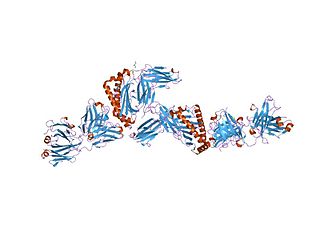Related Research Articles

The X chromosome is one of the two sex-determining chromosomes (allosomes) in many organisms, including mammals, and is found in both males and females. It is a part of the XY sex-determination system and XO sex-determination system. The X chromosome was named for its unique properties by early researchers, which resulted in the naming of its counterpart Y chromosome, for the next letter in the alphabet, following its subsequent discovery.

A protein family is a group of evolutionarily related proteins. In many cases, a protein family has a corresponding gene family, in which each gene encodes a corresponding protein with a 1:1 relationship. The term "protein family" should not be confused with family as it is used in taxonomy.

In evolutionary biology, conserved sequences are identical or similar sequences in nucleic acids or proteins across species, or within a genome, or between donor and receptor taxa. Conservation indicates that a sequence has been maintained by natural selection.
SOX genes encode a family of transcription factors that bind to the minor groove in DNA, and belong to a super-family of genes characterized by a homologous sequence called the HMG-box. This HMG box is a DNA binding domain that is highly conserved throughout eukaryotic species. Homologues have been identified in insects, nematodes, amphibians, reptiles, birds and a range of mammals. However, HMG boxes can be very diverse in nature, with only a few amino acids being conserved between species.
In molecular genetics, the Krüppel-like family of transcription factors (KLFs) are a set of eukaryotic C2H2 zinc finger DNA-binding proteins that regulate gene expression. This family has been expanded to also include the Sp transcription factor and related proteins, forming the Sp/KLF family.

The Argonaute protein family, first discovered for its evolutionarily conserved stem cell function, plays a central role in RNA silencing processes as essential components of the RNA-induced silencing complex (RISC). RISC is responsible for the gene silencing phenomenon known as RNA interference (RNAi). Argonaute proteins bind different classes of small non-coding RNAs, including microRNAs (miRNAs), small interfering RNAs (siRNAs) and Piwi-interacting RNAs (piRNAs). Small RNAs guide Argonaute proteins to their specific targets through sequence complementarity, which then leads to mRNA cleavage, translation inhibition, and/or the initiation of mRNA decay.

Melanoma-associated antigen 1 is a protein that in humans is encoded by the MAGEA1 gene.
POU is a family of proteins that have well-conserved homeodomains.

Melanoma-associated antigen 4 is a protein that in humans is encoded by the MAGEA4 gene.

Melanoma-associated antigen 2 is a protein that in humans is encoded by the MAGEA2 gene.

Melanoma-associated antigen C2 is a protein that in humans is encoded by the MAGEC2 gene.

Melanoma-associated antigen D2 is a protein that in humans is encoded by the MAGED2 gene.

Melanoma-associated antigen 11 is a protein that in humans is encoded by the MAGEA11 gene. It is also involved in the androgen and progesterone receptor signaling pathways.

Melanoma-associated antigen 12 is a protein that in humans is encoded by the MAGEA12 gene.

Melanoma-associated antigen D4 is a protein that in humans is encoded by the MAGED4B gene.
Dual-specificity phosphatase is a form of phosphatase that can act upon tyrosine or serine/threonine residues.

Protein FAM46B also known as family with sequence similarity 46 member B is a protein that in humans is encoded by the FAM46B gene. FAM46B contains one protein domain of unknown function, DUF1693. Yeast two-hybrid screening has identified three proteins that physically interact with FAM46B. These are ATX1, PEPP2 and DAZAP2.
A protein superfamily is the largest grouping (clade) of proteins for which common ancestry can be inferred. Usually this common ancestry is inferred from structural alignment and mechanistic similarity, even if no sequence similarity is evident. Sequence homology can then be deduced even if not apparent. Superfamilies typically contain several protein families which show sequence similarity within each family. The term protein clan is commonly used for protease and glycosyl hydrolases superfamilies based on the MEROPS and CAZy classification systems.

Coiled Coil Domain Containing protein 42B, also known as CCDC42B, is a protein encoded by the protein-coding gene CCDC42B.

MAGEA10 is a protein-coding gene in humans clustered at chromosomal location Xq28.